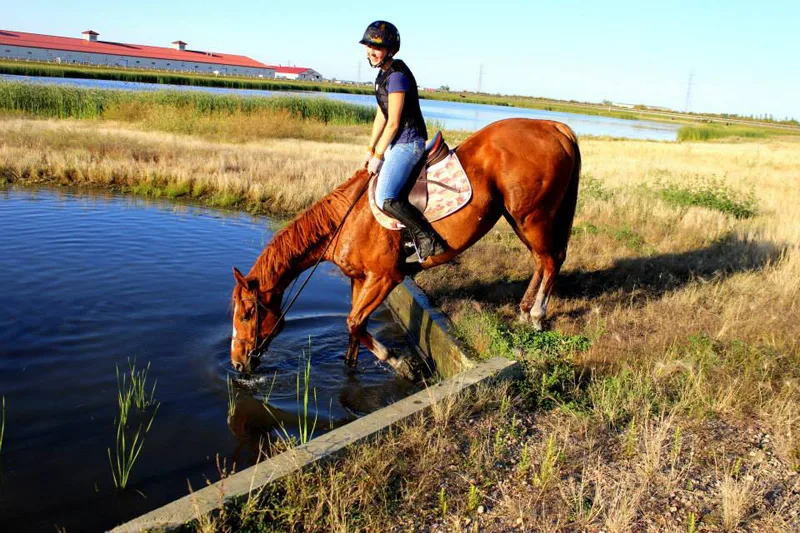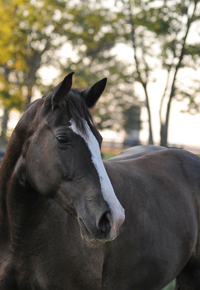Jitterbug is a world-renowned expert in human management and training and has long been respected for her wisdom and sharp eye, as evident in her well-read columns here on The Chronicle of the Horse. From time to time she receives specific requests for feedback from fellow quadruped trainers or especially enlightened bipeds. Today, she premieres a new series honoring a long-held tradition in equestrian sport of judging others’ abilities based on photographs.
If you would like to submit a photo to Jitterbug for her expert critiques, please email the Chronicle at jitterCOTH@gmail.com.
 This gelding’s human has turned him out beautifully with clean tack and what I assume is a reasonably neat braid job since I don’t see any hairs sticking up. The biped seems to be appropriately attired with tidy gloves, and while her upper body is in a good position, her lower leg has slipped back.
This gelding’s human has turned him out beautifully with clean tack and what I assume is a reasonably neat braid job since I don’t see any hairs sticking up. The biped seems to be appropriately attired with tidy gloves, and while her upper body is in a good position, her lower leg has slipped back.
It would seem from the height of his jump that this gelding’s talents are being severely underutilized at this low level. I have always said, “Jump for the level you want, not the level you’re entered,” and this guy clearly gets it. It’s hard to say whether the human’s leg has slipped back because she wasn’t ready for this lesson, or whether her calf strength is part of his reasoning for keeping them at beginner novice.
He has also chosen this opportunity to sharpen the human’s eye, which is an important and long-term process. In this case, he has opted for the close spot—a strategy I like to use when I’m bored with small fences or when I want to emphasize to the human how important it is to use leg—or lose it.
 Sometimes we as teachers choose our teaching moments, and other times they just happen. Hydration is so important for both you and your biped, especially on cross-country. A dehydrated human is a whiny one, and a proper cross-country school can go on for a long time (especially if they spend part of it on the ground). I applaud this horse’s attempt to lead by example.
Sometimes we as teachers choose our teaching moments, and other times they just happen. Hydration is so important for both you and your biped, especially on cross-country. A dehydrated human is a whiny one, and a proper cross-country school can go on for a long time (especially if they spend part of it on the ground). I applaud this horse’s attempt to lead by example.
However.
ADVERTISEMENT
Every moment you are either training your human or untraining her. Technique while teaching is very important. Here, this quadruped is using a drop-down fence as a spot to grab a drink, which has the unfortunate result of teaching the human these obstacles can be moseyed through casually. I would likely have chosen a hydration demonstration along the edge of the water. However, since they’ve come this far, I’d advise the quadruped instructor to really push off with the hind legs when descending the rest of the way into the water. His human is not leaning far enough back, in my opinion, and she needs a good jolt to remind her to stay out of his way. He does have her heels positioned appropriately, however, and he has taught her to shine their saddle properly. The human has shined him up decently well but needs to pull his mane. I’d suggest finding the nearest burr patch and have a goodheadscratch.
Bold and resolute is how I would describe this quadruped’s technique. This redheaded mare has grasped what many quadrupeds fail to understand early on; the warm-up ring is no place to hold your punches. It’s tempting to use this time for last-minute pep talks or even to catch up with your friends (Pepper! Let’s grab some hay later, doll!), but you cannot allow yourself to become distracted. This is your time to catch major problems like floppy legs and loopy reins. The human needs to get a sense for proper control and pacing in cross-country warm-up, not on course.
This mare is doing a fantastic job hitting the line between, “No, I’m not kidding, this is a rear,” and “The Black Stallion attacking that snake.” Her ears are appropriately tilted back to check on the human’s reaction to this ballet-like movement. It appears that her biped’s lower leg has slipped back, which means the mare needs to initiate more no-stirrup work. I imagine that may happen as soon as they land.
From what I can see, the human is well-outfitted for a casual horse trial. The pom pom on top of her helmet cover will make her easier to find in longer grass.
 |
Jitterbug is a Michigan-bred Professional Draft Cross who skillfully avoided saddles until age 5. Since then, she has been lauded for her talent in successfully managing humans while training herself to one day achieve eventing greatness. Jitter and her human live in central Kentucky. Read all of Jitter’s COTH columns. Follow Jitterbug on Facebook! Photo by Dark Horse Photography. |















